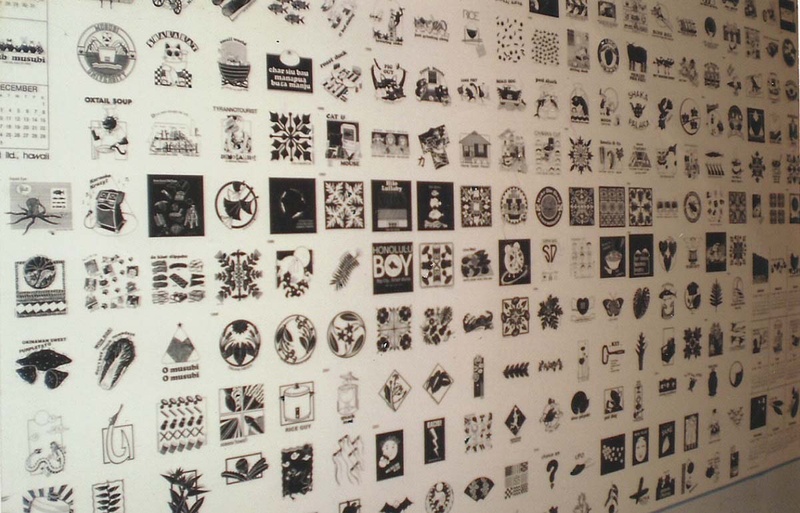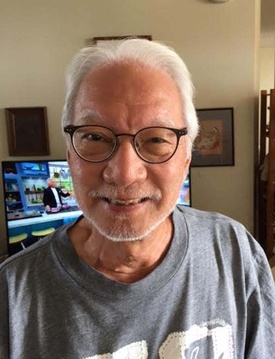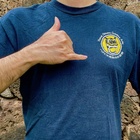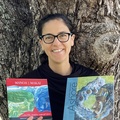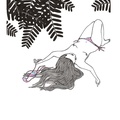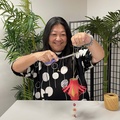Grant Kagimoto stay da creative genius behind Hawai‘i’s iconic T-shirt brand, Cane Haul Road. For almost 50 years he been coming up with clever graphic designs that comment on Hawai‘i’s unique Local culture. Sometimes he get designs das humorous like his Chinese cabbage design with da caption “won bok not much nowdays.”
And oddah times his designs might be pure Hawai‘i nostalgia like his rendering of one big-wheel, hand-crank shave ice machine that takes da viewer back to one time when every neighborhood had one mom & pop corner store.
Recently I wen go talk story with Grant and he wen go share da secret origin of his company and reveal who da person he most grateful to for setting him on his path, his Cane Haul Road to success.
* * * * *
How would you describe one Cane Haul Road design to da unfamiliar?
We’re trying to celebrate what is special about Hawai‘i. A classic example is one of our early designs was a saimin bowl where it said “hardly any char siu nowdays.” It was a comment on the economy, how char siu, the most expensive ingredient in a saimin was getting thinner than ever. One person’s comment was “Wow, you guys are upper class. We had Spam!” That’s what I like about the work. We wanna tell a story and then get a reaction from the viewer. They have their own story, their own ingredient to add to the story that we’re telling.
Try talk about da 1970’s when had one explosion of Local expression in Hawai‘i.
In the 70’s there was this recognition that if you were Local, that was a good thing! That wasn’t something you had to apologize for. That wasn’t something you had to go well, I’m Local, but outside of Hawai‘i there’s all this better stuff going on. There was enough good stuff here and that was enough for us.
In music there was the Sunday Manoa, the Cazimeros, Olomana, C&K, Kalapana. And then on stage there was Local comedian Frank DeLima and Booga Booga. And in writing, there was the beginning of Bamboo Ridge, a press devoted to publishing Local literature. There had been other Local things that had gone on before, but there was a real blossoming of people in their 20’s in all these fields that were really exciting and we could look and see there were people like us doing it.
Hula was having a renaissance. People like Larry Kimura were recognizing that the Hawaiian language was really important and needed to be saved and it needed to be recognized as the official language of Hawai‘i.
Without that kind of magic in the air, I don’t think a company like ours would’ve been able to survive because we would’ve been out of the mainstream. At that time, we were the mainstream! We were very lucky. Our timing was perfect. At craft fairs people would stand in long lines to buy our stuff. When I would take shirts to one of the stores in Kapahulu, Something Special, even before I got it out of the box people were grabbing it. That’s how hot we used to be.
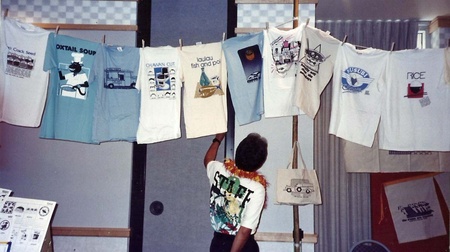
You can try tell exactly how you got started.
We started in 1975, but we incorporated in 1977. So if you do the math it’s been either 46 or 48 years. In 1975, a guy named Gary Fujimoto had a commercial clothing company and my friend Mary Mitsuda was helping Gary silk screen. Gary was getting kind of burnt out so he said to Mary, “Gather a bunch of your friends together and I will teach them how to be in the commercial wholesale world producing lines of products for stores.” And in return he was gonna get energy and new ideas from us.
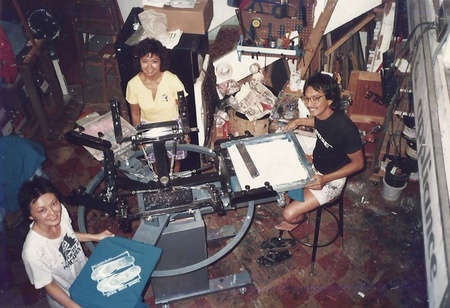
One of the things Gary impressed upon us was that once we decided to do this, we couldn’t decide after a few months that it wasn’t fun anymore and just quit because that was very unprofessional and it would leave a bad taste in the mouths of buyers for other young people who would come along after us. After a short while, a bunch of people who were part of our original group, actually most of them, decided that this wasn’t for them.
But Carol Hasegawa and I felt that we had this obligation so we stayed together. She would do some of the designing, but mostly she would handle the backroom stuff and the planning. Then a little over 10 years into in, Carol decided she wanted out of the partnership and it ended up being just me.
And so how you got da name Cane Haul Road?
I think there were 9 to 12 of us art people when we originally started and one of our assignments was to go home and come up with names for the company. My contribution was Pāhoa Produce. Nobody liked that. Marie Kodama suggested Cane Haul Road. And I thought that’s not a good idea. And so I was the only one who voted against it.
The irony is I’m the one who’s stuck with the name! But it’s turned out to be a good name because we have specialized in the early plantation ethnic groups in our designing. It’s turned out to be an awkward name now because if you’re 30 and under you probably have no idea about that kind of plantation lifestyle. It’s really old history now.
You can explain what Cane Haul Road means to da people who not familiar.
When you drive around in the country on the islands when the sugar mills were in existence, you would see these Cane Haul Road signs posted all over in the cane fields. I think it meant if you were out there riding your bicycle or fooling around on the road and the cane truck came and ran you over, then it was YOUR FAULT (Laughing) because these were kind of official plantation roads that were used for their business purposes.
(Laughing). Das funny. I only knew da literal meaning. I nevah know da hidden meaning, da kaona. Eh, you eju-ma-cated guy, ah, what school you went, what year you grad?
I went to Union School for kindergarten in Hilo. From first grade on I went to school in Okinawa. My father worked for the federal government and they were there for 20 years. So I graduated from Kubasaki High School in 1966. There were a whole lot of Hawai‘i people there so we had a very strong Hawai‘i identity at the school.
So being one insider and outsider wen help you den?
If I hadn't moved away I wouldn't be able to do what I do today. If I just stayed in Hilo my whole time growing up I wouldn't be able to see what was so special about Hawai‘i.
So how you identify yourself as? Local? Japanese American?
I identity with being a Sansei. And I tell people I was born in Hilo. I don’t tell people I’m from Hilo because I left at 6. I tell people that I’m a Haole and I use that word not racially, but I use it in terms of I’m a foreigner.
I’m not really a Hawai‘i person because of my experience growing up in Okinawa. But I’m not really an Okinawa person in terms of being an Okinawan. I have a couple of designs, one of them is the islands of Hawai‘i and it says “Home.” I have another design that’s the island of Okinawa and it says “Heart.” So I think that kind of captures who I am.
If I had to choose to live anywhere I would choose to live in Hawai‘i. I can’t really live in Okinawa because I don’t speak the language and I don’t have an extended family there as I do here.
So you identify as one Haole Sansei?
(Laughing). Yes. I want to do a shirt for myself saying “I’m not so Naichi.” The pun is “I’m not so nice,” which I think is kind of true. But it’s also I don’t wanna take responsibility for all the shortcomings of being Japanese. That’s one of my ways of looking at myself as being Japanese American—I’m very much aware of the many things Japan as a country has done around the world throughout history.
What wuz your most popular design ova all da years?
It’s a design called “Home Sweet Hawai‘i” and it’s a plantation house. I realized when I did the initial drawing, it was really a weak drawing, so I asked an artist named Arthur Kodani to redo it and give it some life. That design was an immediate hit. People would come up to me almost with tears in their eyes and say, this is my Grandmother’s house or my favorite Uncle’s house in the country. So it really struck an emotional cord.
You Japanese, but you get designs that incorporate stuff from Hawaiian, Filipino, Chinese, Okinawan, and oddah cultures too. Is that cultural appropriation or what? Does it seem more that way today than before time?
I think it is less PC now. One of the things that separates us in Hawai‘i is that we can make fun of each other with impunity because our families are so blended. I have Filipinos in my family. My cousins are married to Filipinos, so I wouldn’t slight people in my own family. I do not do Filipino jokes, but if I do a Filipino design hopefully I’m doing designs that celebrate things that are Filipino.
And I limit myself to the sugar plantation era. I don’t do Micronesian, Tongan, and Samoan, because there’s just so many other immigrant groups now, Vietnamese, Cambodian, Thai. That’s just too complex for me. I want to concentrate on a time period that I’m sort of familiar with.
How does it feel for be one Local institution?
When we were in design school our teacher told us when you put your name on a design, you wanna be able to go back to it years later and look at it and think it’s still legitimate, it’s still well done and you’re giving something to your community and not just ripping off your community. And now we are in a position where I can look back and say yeah there’s designs from 20, 30, 40 years ago that still resonate with me and the community. Younger people are coming up to me now saying I found this in a thrift store, we didn’t know you were still around. (Laughing).
If you had for express tanks for somebody who wuz instrumental to helping you along da way, who would that be?
When I was at UH [University of Hawai‘i] I was what they call a general major. I had a choice between music, drama, or art. So I took Art 101 because I didn’t wanna stand up on stage and make a fool out of myself. I was too shy to do that so I took Art 101.
The professor, Duane Preble would bring outside speakers in and one of the speakers was a guy named Bruce Hopper who was a graphic designer. When Bruce came in and showed his work, the lightbulb just went off immediately for me. I said that’s what I want to do. I wanna be a graphic designer to be able to communicate ideas and stories and publicize things.
So what does da future hold for Cane Haul Road?
I really don’t know. This whole business is an accident. Nothing was planned. My future is the same way. I keep on threatening to retire, but I’m always afraid I'll just watch YouTube all day. And maybe all night too. (Laughing).
© 2023 Lee A. Tonouchi


